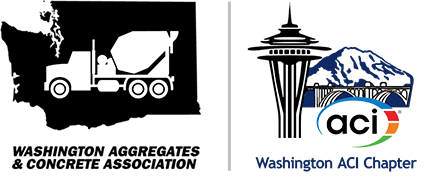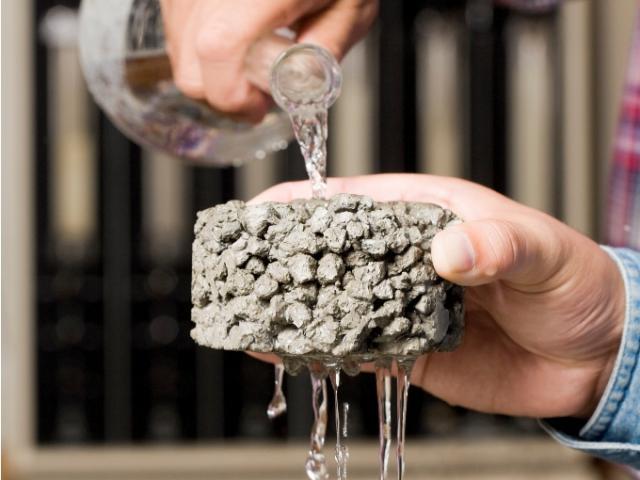Pervious ConcretePervious Concrete is quickly becoming a primary storm water management tool for LID projects throughout WA state. Our Association provides NRMCA Certification testing for all types of users; materials & inspection, placement, and specifiers and agencies. We build certification classes based on interest. If you are interested in a class, please call the Association office at (206) 878-1622 or by email at [email protected]. For technical questions, please contact [email protected]. For a printable version of our Pervious Concrete Flyer, CLICK HERE. IMAGINE THIS...NO STORM WATER RUNOFF!
Proper specification of Pervious Concrete is important. Specifications must clearly communicate project objectives while recognizing the characteristics of Pervious Concrete are very different from conventional concrete and traditional concrete elements do not apply. Specifications should only incorporate specific criteria as it directly relates to Pervious Concrete based on known and recommended practices. For project specifications consult: ACI 522.1-08; Specification for Pervious Concrete Pavement documents may be obtained online at: www.concrete.org
Pervious concrete is a 2 part on site filter for storm water in a dry detention system consisting of the Pervious Concrete Pavement and a coarse gravel retention layer for storm water storage. Design of the retention layer is a site specific task and should take into account, percability and characteristics of native soils, volume of storm water anticipated, rate of flow, and duration. An initial soils survey and site specific storm water calculations should be performed by a storm water management engineer.
PLACEMENT OF PERVIOUS CONCRETE
Specifications should require Pervious contractor crews to be certified and experienced according to ACI 522.1-08. NRMCA Pervious Certification programs are administered by the WA Aggregates & Concrete Association and define 3 levels of Certification. Pervious Contractor crews should be qualified to the "Installer" level of certification. Click on: www.nrmca.org/certifications/pervious Conventional concrete equipment and placement methods are not applicable to Pervious Concrete. The contractor's compactive methods and equipment must be considered in conjunction with the pervious concrete mix design for an efficient and economical placement.
Pervious concrete is a specialty concrete and specialized equipment and experience are necessary to successfully construct the Pervious Concrete Pavement. Test panels may be recommended to verify concrete quality and the contractor's placement method and equipment.
As for any concrete pavement, proper curing is essential. Positive curing with visqueen should be accomplished as soon as practicable but no more than 20 minutes after placement procedures. Visqueen must be properly secured, monitored and left in place for no less than 7 days. TESTING AND INSPECTION Many normal concrete field inspection and testing practices do NOT apply to Pervious Concrete. Standard ASTM tests for Strength, Slump, and Air content should NOT be criteria used for acceptance of Pervious Concrete. ASTM C-138 (Unit Weight) modified by ASTM C-29 (Jigging method) is used to confirm the unit weight of the freshly delivered Pervious Concrete. Cores may be taken in accordance with ASTM C-42 for the measurement of pavement thickness; (ASTM C-174), and the density of the cores determined in accordance with ASTM C-140. Non applicable or non standardized test methods not designed specifically for Pervious Concrete to measure density or void content in the hardened cores is NOT recommended. WHAT ABOUT FREEZE OR THAW? Pervious Concrete is not designed nor intended as a storage area. Water passes directly through the pavement and into the gravel retention layer below. Freeze / Thaw is not a concern in western Washington as NW temperatures and freeze/thaw conditions are nominal. Pervious Concrete should not be placed during freezing temperatures. WHAT ABOUT CLOGGING? Clogging of any pervious pavement or surface may be a concern. It is highly unlikely a majority of any pervious surface will become 100% clogged. Leaves and conifer needles are easily removed. Water will always seek the next point of infiltration. WHAT ABOUT MAINTENANCE? Good common sense approaches are required to prevent run-on of landscaping, storage of materials and construction activity on a Pervious Concrete surface. If necessary, monitor site characteristics and implement a regular cleaning schedule of any pervious surface. For parking areas, your regular program for sweeping should be sufficient. NEED MORE INFORMATION? To learn more about Pervious Concrete, contact your local Ready Mix Supplier or NRMCA Certified Pervious Contractor!
|

